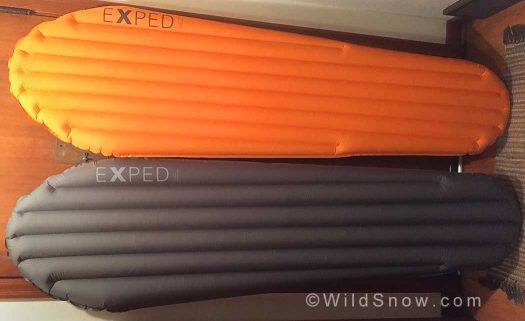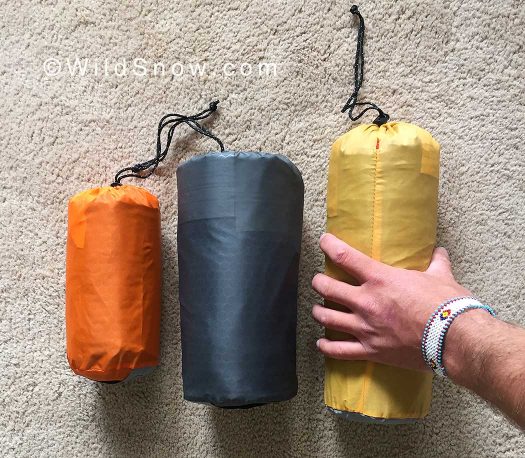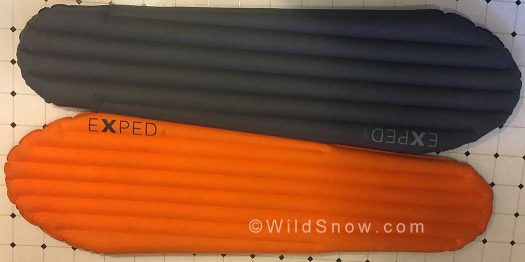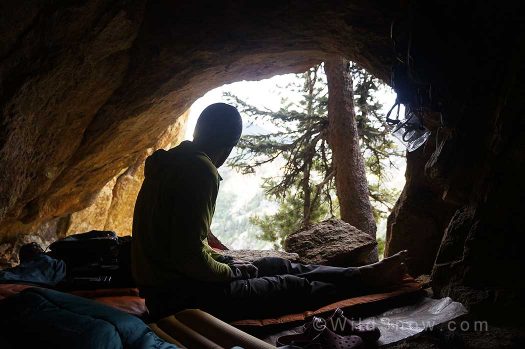
Waking up in a cave in the North Cascades, the Exped Synmat Hyperlite and the Synmat 7 keeping things comfortable. The wolverine who lived there was impressed.
With different adventure agendas come different sleeping systems. Are you looking for a lightweight minimalist bivy pad that is used in combination with other parts of your kit? Or are you hitting the road for a several week ski touring trip and looking to live the life of luxury in your camper or van?
Whatever the case, your sleeping pad is one of the most critical pieces of your sleeping system — perhaps THE most critical.
I have been a fan of lightweight inflatable pads for a long time, as they provide the best ratio between weight, space, and insulation. This comes with a cost of course. If you receive an irreparable puncture to your pad, you quickly go from a night of comfort and bliss to sleeping on a thin piece of plastic that will be nothing short of useless — or downright dangerous. (I’d imagine many of you reading this have experienced that incredible sinking feeling…)
With careful handling (what I refer to as popped-pad-paranoia) and a good pad, you can enjoy many sleep-full nights.
For the last four years I have been using pads from Exped (Expedition Equipment). The company began as a distributor, but have been making their own gear since 1997. Initially, I only knew about their pads, but I have since seen more and more of their gear on the market; everything from pads, to backpacks, tents, and even hammocks. In fact they have over 80 styles and sizes of sleeping pads to choose from. In general, I have seen quality products come out of Exped, and despite a case of baffle delamination, their customer service has provided an easy and speedy replacement.
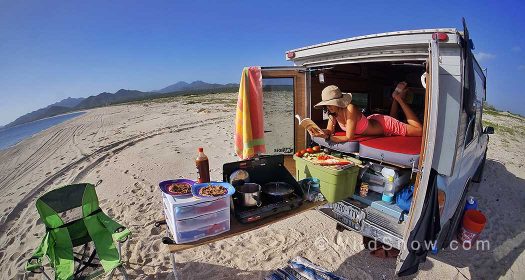
We tested Exped Megamats, a purely car camping, sleeping-at-your friend’s-house-for-weeks or even used as an everyday mattress, type of pad.
For expedition purposes, I have used three of their insulated lightweight mats (as compared to other bulkier options). I’ll highlight them here.
Synmat Hyperlite Pad
Uses: summer backpacking and climbing trips as well as winter ski trips with more moderate temperatures.
Specs:
R-Value: 3.3
Length: 72 inches (for the medium version)
Width: 20.5 inches
Tapered shape towards the legs and feet
Weight: 12.3 oz
This pad has been my most common go to for its size, warmth, and weight. It has synthetic insulation and one easy to use one-way valve. If you had to go for the one-mat-fits-all for winter, summer trips, I would cast my vote here (but I am typically a warm sleeper).
Pros
Cons
Downmat Winterlite Pad
Uses: Winter ski expeditions with colder temperatures.
Specs:
R-value: 7
Length: 72 inches (for the medium version)
Width: 20.5 inches
Same tapered shape as the Synmat Hyperlite
Weight: 16.8 oz
Downmat Winterlite is perfect for longer ski expeditions where warmth is more critical, like storm watching in Glacier Bay National Park. The additional weight from the added insulation has deterred me from taking it out, if I am looking for places to cut weight. It also doesn’t pack up quite as small as the Synmat Hyperlite. The same single one-way valve works well.
Pros
Cons
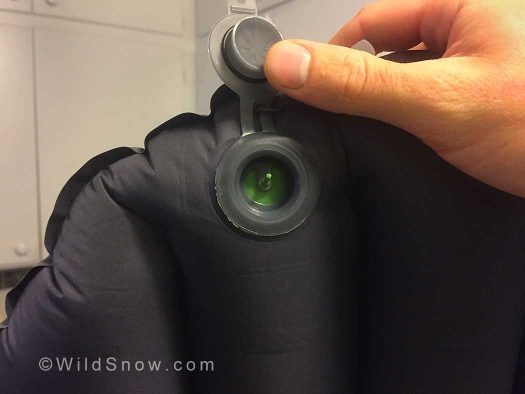
The Synmat and Downmat Lite pads both have a single 1-way valve. This is one of the best valves I’ve used on an inflatable pad. When it is open, it still provides a fully sealed airway.
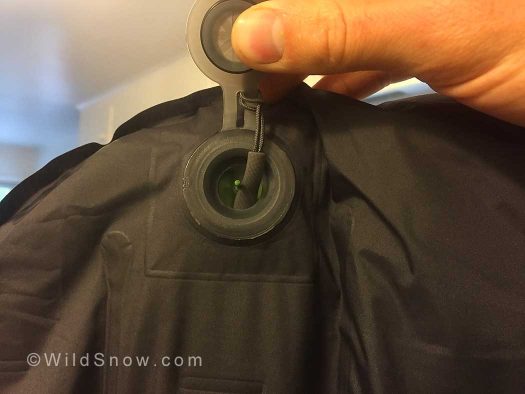
To deflate with the one-way valve, you have to insert the tab to break the seal. This has proven to be highly effective at dumping air from the pad when it’s time to pack up.
Synmat UL 9
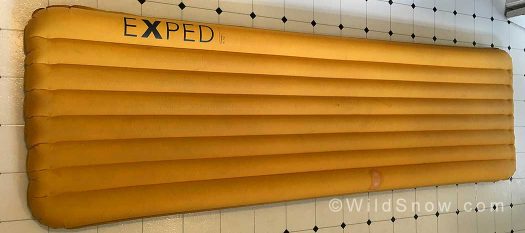
The Synmat UL is a straight-sided pad that is good for longer trips where you can afford to carry a slightly larger pad and a bit more weight. This pad features 2 one-way valves. One to inflate, and one to deflate.
Uses: Kayaking expeditions, car camping, and backpacking trips where I am not overly concerned with packability.
Specs:
R-value: 6
Length: 77.6 inches
Width: 25.6 inches
Straight sided shape
Weight: 28.6 oz
This pad is an excellent choice if you’re looking for more comfort on a trip. With the straight sided shape and the thickness after inflation, it provides a high comfort to pack-ability ratio. Of course, it is almost twice the weight as the Hyperlite versions, and that is primarily why I take it on kayaking expeditions where I can afford to schlep a little added comfort.
Pros
Cons
Overall, these Exped mats are quality choices for a sleeping system. With the one-way valves it makes it easy to inflate them without the risk of passing out before your bed is set up. All of the pads above have slightly large side baffles that help keep you on your pad at night, this is a huge bonus if you’re a moving sleeper. Additionally, the one-way valve allows you to quickly dump air when it’s time to pack up. I can simply open the valve and start rolling it from the bottom and it packs down almost to the same size that it comes in from the store (this is a hard feat to accomplish).
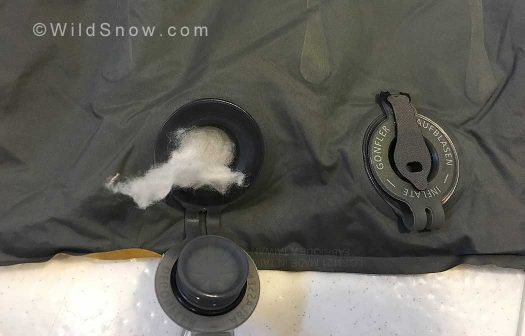
I have had a slight issue with the synthetic insulation leaking out of the deflate valve. It is a small amount, and causes no major problems. The insulation can collect debris, which you’ll want to avoid putting back into the pad for risk of damage.
One thing I have noticed with the Synmat pad is the synthetic insulation coming out slightly from the deflate valve over the years. This hasn’t been a major problem (other than occasional collecting debris), as I can just stuff it back in, but it could be solved with a small mesh screen on the inside of the valve. Also, like I said earlier, I have had issues in the past (3 years ago) with a baffle delaminating, which essentially turned my Synmat into a tubular pool toy (not awesome on a multi-day trip). Exped sent me a replacement quickly.
During this time I was inflating my pad by blowing into it, and I realized this caused a build up of condensation and ultimately mildew because it could not be adequately ventilated. It was my conclusion that this led to adhesive failure in the baffles and caused the delamination. Since then I have been using Exped’s Schnozzle Pump Bag. At first glance, this seemed like the most ridiculous accessory I had ever seen, but after using it now for almost 2 years I won’t go without it. The Schnozzle bag can be used across all of Exped’s products, and allows you to pump up your pad way faster, without lung power, and keeps the inside of your pad dry. I have had absolutely no issues with delamination, or getting lightheaded while trying to set up my bed.
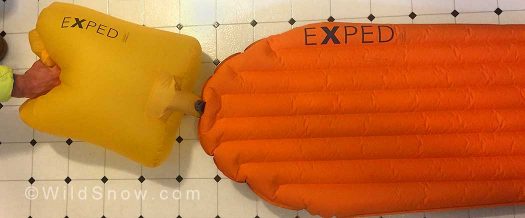
The infamous schnozzle pump bag in action. A seemingly ridiculous contraption is highly effective and weighs almost nothing. Some versions of the schnozzle bag double as a light weight dry stuff sack.
Exped has a very extensive sleeping mat (as they call them) collection. It can be a little overwhelming to figure out what you want when you look at their website. Here is my attempt to guide you through the lingo:
First there is the family name: AirMat, SynMat, MegaMat, etc. This is the place to start. Figure out if you’re looking for an expedition mat, something super insulated, ultra light, or something for car camping. Their website has a system to help with this at the top of their mat section.
Second, many of their mats have a number in the name. This is speaking to the thickness of the mat from the surface that you’d be sleeping on to the ground surface. This number is in centimeters. For example, SynMat 9 is nine centimeters thick.
Next you’ll find some acronyms in the name. Here is a key:
UL ultra light
XS extra small
S “small”
M medium
LW long and wide
MW medium length and wide
LXM long and extra wide
SIM self inflating mat
XP external pump. This is to specify it against other versions in the same family that have a built in pump system.
TT tube technology. Meaning that each air cell is isolated and can be replaced individually.
Lastly, they have some of their mats in a “duo” version. These are two person sleeping pads.
You can shop for Exped mats here.
Update: Exped has changed the laminate they are using in their pads this year to solve the blown baffle issue. As always, Exped will
replace pads with manufacturer’s defects quickly and for free.
For more information on the differences in pads you can watch this video.

Jonathan Cooper (“Coop”) grew up in the Pacific Northwest and has been playing in the mountains since he was a teen. This was about the same time he made the fateful decision to strap a snowboard to his feet, which has led to a lifelong pursuit of powdery turns. Professionally speaking, he has been working as a ski guide, avalanche educator, and in emergency medicine for over a decade. During the winter months he can be found chasing snow, and passing on his passion for education and the backcountry through teaching avalanche courses for numerous providers in southwest Colorado, and the Pacific Northwest. Similarly, his passion for wilderness medicine has led him to teach for Desert Mountain Medicine all over the West. If you’re interested, you can find a course through Mountain Trip and Mountain West Rescue. In the end, all of this experience has merely been training for his contributions to the almighty WildSnow.com.

